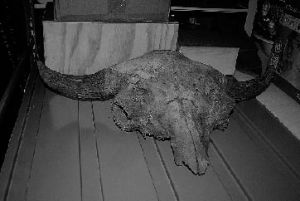The discovery of ancient bison bones in an Orcas Island peat bog a few years ago is changing researchers’ ideas about the arrival of humans in the New World, and the extent of the ice-age glaciers. The bones lend credence to the idea that the Pacific Coast offered a food-rich ecosystem for ice age hunters some 14,000 years ago – much earlier than the prevailing scientific theory pegs the arrival of humans to the New World.
Remains of the extinct species Bison antiquus – an ancestor of the plains buffalo that would become a staple much later for Midwest natives – show the islands were once part of a coastal grassland refuge from the glaciers that enveloped the rest of Canada and the northern U.S. at that time. And among the relics found on Orcas is a leg bone from that appears to have been butchered by a human – hundreds of years before humans were thought to have migrated to North America.
Recent re-examinations of the bones, and others like them from Vancouver Island, fully illuminated its significance, said Michael Wilson, an archeologist at Douglas College. He is the co-author with U.S. archeologists Steve Kenady and Randall Schalk of several new studies detailing the bison-bone sites.
Wilson, Kenady and Schalk gave a talk on the Orcas Bison antiquus skull at the Society of American Archaeologists meeting in Vancouver, B.C. on March 30, explaining their research, which was reported in the Vancouver Sun on March 25.
“The way that this research has evolved shows the enormous importance of museum collections in storing and interpreting a local region’s heritage,” he added. “Many people wonder at the value of old specimens ‘stored away’ in the back rooms of museums, but this clearly shows how they can take on new significance over time, as other discoveries are made.”
Last week’s international archeological conference follows the publication of a U.S. study earlier this month in the journal Science that proposed a new “working model” for when and how ancient humans first spread from northeast Asia to the northwest corner of the Americas.
That study – along with the bison finds and a growing number of other archeological sites suggesting an earlier arrival for humans to this hemisphere – substantiates a controversial theory that ancient seafarers, travelling by boat along the ice-fringed B.C. coast, launched the migration of people to the New World about 15,000 years ago. The Vancouver and Orcas Island discoveries also indicate that these pioneering hunters could have relied on much more than seafood to subsist in their new North American home, argues Wilson.
Whether based on seafood or bison meat, the picture of shoreline hunters sketched out in the emergent “coastal migration” theory challenges a long-held view that the earliest newcomers to North America were big-game hunters who arrived about 12,500 years ago from Siberia, pursuing mammoths and other ice age prey across the dried-up Bering Strait to Alaska and Yukon, and eventually into the warmer continental interior through an ice-free corridor east of the Rocky Mountains.
The team writing in Science, headed by Texas A&M University anthropologist Ted Goebel, concluded that both the coastal and ice-free corridor migrations probably occurred.
Micki Ryan, Orcas Island Historical Museum Director, said, “I am delighted to see so much attention paid internationally to the discovery of Bison antiquus remains on Orcas Island. Dr. Wilson, a professor of paleogeography, has given two public presentations on Orcas in the past two years about this find, and the property owners gifted the important ancient bison bones to the Orcas Island Historical Museum last year.”
During Burke Museum Director Dr. Julie Stein’s recent visit to Orcas Island, she viewed the bison skulls and offered comments on some of the controversial aspects of presenting new scientific information to the established archaeological community. These discoveries give a nudge to established thought about human occupation of the west coast, annoying some scientists and tantalizing others, said Ryan.
Wilson and Kenady are assisting the museum with developing an interpretive exhibit for 2009 about the paleoenvironment on Orcas that they theorize opened a land bridge between mainland Canada and Vancouver Island for passage of these ancient bison herds and the human hunters who followed them, said Ryan. Three distinct finds of bone materials, some showing presumed human butchering marks, were made across Orcas Island.
Ryan says that she received a note from archaeologist Steve Kenady about their presentations to the international symposium of archaeologists on Sunday morning, March 31st.
“Some archaeologists are annoyed by the discoveries, as they upset established thinking – that is why this presentation was scheduled for early Sunday morning, when most participants would be heading for the airport. But Steve said every chair in the room was filled by 8 a.m., with scientists eager to hear about the Orcas Island finds – a full hour before the presentations were scheduled to begin!”
The Orcas Island Historical Museum administers a Bison Research Fund created from individual donations. The fund assists with costs of laboratory and field tests to continue building the argument for paleoindian occupation of Orcas Island prior to the last ice age. The bison found on Orcas were tested and found to be as old as 11,760 years. The museum store will carry reprints of the scientific journal articles about the bison finds and their implications for early human life here when the museum reopens its exhibits on May 23, 2008.
Donations to the Bison Research Fund for continued research, or to the Orcas Island Historical Museum for development of interpretive exhibits, are always welcomed, Ryan adds. “Exhibit development will be costly as we hope to have a full-size realistic touchable model of the nine foot tall bison made for an environmental diorama of Orcassia, the name Dr. Douglas has given to the ancient land bridge.” Contact museum director Micki Ryan at 376-4849, for more information.



